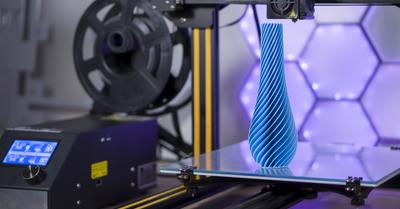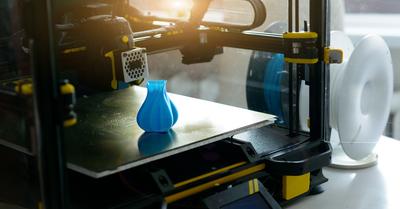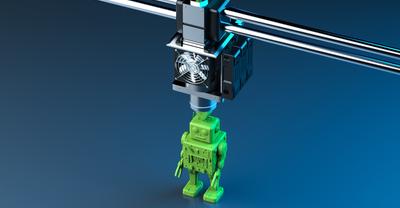Here’s How Long a 1kg Spool of Filament Is
There are three most popular printing materials: PLA, ABS and nylon. They all have their pros, cons, and weight differences!
- PLA is cheaper and easier to work with, but denser and thus heavier
- ABS is a touch more expensive, harder to work with, and the material can be more durable—but is less dense
- Nylon finds the middle ground in weight but is more flexible and prone to breaking
What’s important between the two is their weight. PLA is denser with 1.25 g/cm^3 versus ABS with a density of 1.04 g/cm^3. This means if you order by weight, you receive a longer amount of ABS material.
Length Breakdown by Material
We’ll cover the main two most popular printing materials, PLA and ABS.
PLA:
- At 1.75mm diameter, the filament will be around 330 meters long
- At 3.00mm diameter, the filament will be around 110 meters long
ABS:
- At 1.75mm diameter, the filament will be around 400 meters long
- At 3.00mm diameter, the filament will be around 130 meters long
You can see more detailed figures on ToyBuilder Labs’s breakdown.
As you can see, PLA is denser than ABS. So, when sold by weight, PLA will be shorter in length. This is very important to keep in mind if you wish to use hybrid-style materials like those with embedded metal. These materials are far denser and heavier so the length will be shorter.
Why Weight and Not Length?
To better answer why filament might be sold by weight and not length, let’s break down what filament is and how it’s used.
To realize why filament is typically sold by weight, we just need to consider what we actually use it for. While it might seem logical at first glance to sell by length, we don’t really print things based by length of filament.
The end project does not turn out as a connection of strands of filament, but instead a perfectly formed 3D piece. When you weigh this piece, if everything goes right, the piece will weigh near the amount of filament the printer used to create it. Selling filament by weight gives us a better idea of exactly how much a given spool can print in volume.
How much material is needed depends on your project and the materials used.
Follow Your Slicer
Depending on what slicing program you use, the estimated total of material or length may vary. This depends on your 3D printer, program, and of course the design you’re printing. Most slicers will offer the weight of the material it will use, while some calculate the length by already knowing the diameter of the filament it’s using.
The issue with using length when printing is that it’s based on basic calculation and doesn’t take into account the density of the material or, sometimes, even the infill used. You may set your printer to print overnight to wake up to the top of the project left unfinished–ruined.
Filament Suppliers Vary
While most suppliers list and sell their filament by weight, a few sell by length. Again, length can be an easier figure for us to understand how much we’ll receive, but doesn’t determine how many projects we can create from that amount.
In addition, if you’re changing filament sizes or perhaps getting a bigger 3D printer that runs 3.00mm filament, you may be daunted by the length being shorter, but still having the same price! You’re simply getting more material in the filament, which some suppliers try to highlight by selling in weight.
Checking What’s Left
A problem with measuring spools of filament is when you try to check how much of a certain filament you have left. Perhaps you forgot take notes on this one spool.
If you were checking by length, what else could you do but unspool it and measure it? That could cause issues with contamination from your hands and tools on the filament, and may bend the filament. We’re not even counting the headache of measuring and respooling the filament.
If you track by weight, you can simply place the spool on a scale and factor out the weight of the spool itself. As simple as that, you get the amount you have left on that spool.
A Demonstration
Let’s take, for example, the famous “Benchy” test figure that many people with smaller 3D printers use to check if their settings are correct.
When the Benchy file is imported into your slicing program, the program will come out with one of two figures. Often it will tell you how much material it estimates to use.
Benchy can be around 13 to 14 grams, and then some additional material for the amount of infill you supply it. Some programs will report a length as the program knows the diameter of your filament. Once printed, Benchy will use around 13 to 16 grams of material to print.
The length of the material needed to create Benchy can vary depending on your 3D printer and how the slicer is programmed to run.
Calculating the Filament Weight in Length
If your slicer only outputs the length, you can calculate the weight using this online calculator. Using this calculator, you can also see that the weight versus length difference is fairly large when comparing different materials:
- 14 grams of PLA is around 5.2 meters of material used
- 14 grams of ABS is around 4.1 meters of material used
To keep track of how much filament material you are using so you can plan for future projects, try to keep a running note per spool you use.
For example, let’s break down the difference in measuring off creating five figures of Benchy as you might if you were dialing in your new 3D printer’s settings.
- If you ordered a 1kg spool of 1.75mm PLA, and made five Benchy figures: 1kg – (5 x 14g Benchy) = 930 grams of material left.
- If you ordered 330 meters of 1.75mm PLA, and made five Benchy figures: 330m – (5 x 5.2m Benchy) = 304 meters of material left.
However, let’s break down the percentage of material used from the spool. By weight, you would use 7% of the material. By length, you would use 7.8% of the material.
This discrepancy can cause issues if you ordered a specific filament, let’s say neon pink, for a set of projects and by the end you find you ordered too much because you calculated it out by the length and might have wasted money you didn’t need to spend.
Figuring Out Filament Length Vs Weight
We hope we’ve given you the right tools and mindset for figuring out the difference between the weight and length of the filament. Regardless of whether you use the length or the weight to measure, keep in mind that some suppliers and some programs prefer weight for more accurate measurement of the amount of materials sold or needed.









